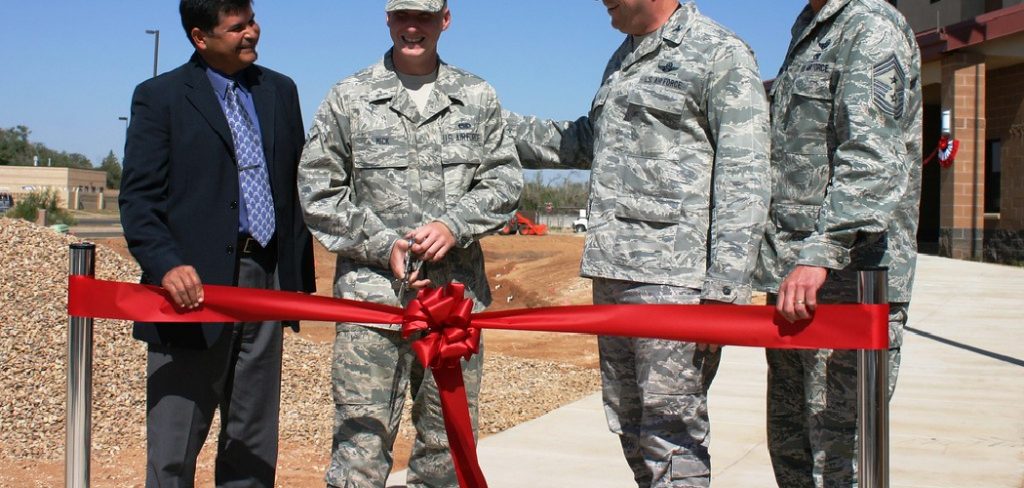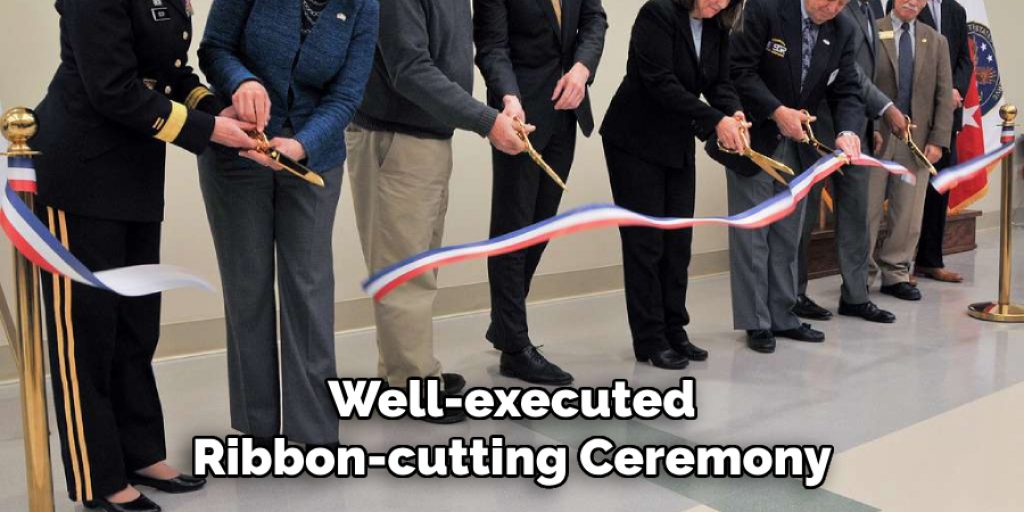How to Do Ribbon Cutting Ceremony
A ribbon-cutting ceremony is a significant event that symbolizes the opening or the initiation of a new establishment, project, or initiative. This ceremonial act is not only a moment of celebration but also a powerful marketing tool, inviting public and media attention to the endeavors of businesses, non-profit organizations, and other entities.

It marks a significant milestone, commemorating the hard work, dedication, and vision that brought a concept to fruition. Whether for a small business, a community center, or a significant corporate launch, a well-executed ribbon-cutting ceremony can generate excitement, foster community relations, and create memorable moments that signal the start of a new chapter. Read to know more about how to do ribbon cutting ceremony.
What is a Ribbon Cutting Ceremony?
A ribbon-cutting ceremony is a traditional event that dates back to ancient civilizations. It involves cutting a ceremonial ribbon with scissors or other suitable cutting tool, typically by distinguished guests or organizers of the event.
The ribbon symbolizes the barrier that has been broken, and its cutting represents the official opening of a new venture. This event often includes speeches, photo opportunities, and refreshments to mark the significance of the occasion.
Ribbon-cutting ceremonies are commonly used in business settings to commemorate a grand opening, product launch, or milestone achievement. They can also be held for non-profit organizations, government agencies, educational institutions, and other entities.
Why is a Ribbon Cutting Ceremony Important?
A ribbon-cutting ceremony is an essential event for any organization because it holds several benefits, including:
Publicity and Brand Awareness:
A well-executed ribbon-cutting ceremony can garner media attention and generate positive exposure for the organization. It is an opportunity to showcase the company’s brand, products, or services to a broader audience.

Networking and Community Relations:
Inviting local business leaders, government officials, and other influential figures to the event can help establish and strengthen relationships. It allows for networking opportunities and fosters community relations, which can be beneficial for future partnerships.
Milestone Celebration:
A ribbon-cutting ceremony is a chance to celebrate achievements, whether it’s the opening of a new business or the completion of a significant project. It provides an opportunity to recognize and thank those involved in making the milestone possible.
Boosting Employee Morale:
Organizing a ribbon-cutting ceremony can boost employee morale and create a sense of pride and ownership within the organization. It allows employees to feel like they are part of something significant and motivates them to continue working towards company goals.
Needed Materials
To host a successful ribbon-cutting ceremony, you will need the following materials:
A Ceremonial Ribbon:
The ribbon should be long enough for multiple people to hold and cut together.
Scissors or Other Cutting Tool:
Choose a pair of scissors that are sharp and easy to handle. Alternatively, you can use oversized scissors or a novelty cutting tool for added visual impact.
Backdrop and Decorations:
A backdrop with the organization’s logo or branding can create a professional and polished look. Additional decorations such as balloons, flowers, or banners can add to the festive atmosphere.

Invitations and Guest List:
Send out invitations to guests well in advance of the event. Make sure to include distinguished guests, media outlets, and community members.
Refreshments:
Provide light refreshments such as finger foods and beverages for guests to enjoy during the ceremony.
11 Step-by-step Guidelines on How to Do Ribbon Cutting Ceremony
Step 1: Plan the Date and Time
Choose a date and time that works best for your organization, keeping in mind the availability of important guests and media outlets. Consider hosting the event during a slow period to generate more publicity. You can also choose to have the ceremony on the same day as the official opening or launch. But make sure to allow enough time for any last-minute preparations. It is also a good idea to have contingency plans in case of inclement weather.
Step 2: Select a Venue
Choose a location that is significant to your organization, such as the new business premises or project site. If the chosen venue is outdoors, make sure to have backup options in case of bad weather. You can also consider using a large tent for outdoor events to provide shelter and shade. It is also essential to choose a location with enough space for guests and photo opportunities. The venue should also have suitable parking and accessibility for all guests.

Step 3: Invite Guests
Create a guest list that includes important figures such as local government officials, community leaders, business partners, and media outlets. Send out invitations at least two weeks in advance and follow up with RSVPs. The guest list can also include employees, friends, family, and other supporters of the organization. You can also use social media and other digital platforms to promote the event and reach a larger audience.
Step 4: Create a Program
Draft a program for the ceremony, including details such as the order of speeches, ribbon-cutting, photos, and refreshments. Allow enough time for each segment and make sure to stick to the schedule. But also be flexible in case of any unexpected delays or changes. It is also a good idea to have a master of ceremonies or a designated speaker to guide the event.
Step 5: Prepare the Ribbon
Purchase a ceremonial ribbon that matches the theme and branding of your organization. It should be long enough for multiple people to hold and cut together. You can also choose to have customized ribbons with your organization’s name or logo printed on the ribbon. Make sure to have scissors or other suitable cutting tools available and easily accessible during the ceremony. You can also opt for a novelty cutting tool for added visual impact.
Step 6: Decorate the Venue
Add decorations such as banners, balloons, and flowers to create a festive atmosphere. Make sure to prominently display the organization’s branding or logo for photo opportunities. You can also consider having a red carpet or backdrop for guests and speakers to take photos in front of. The decorations should match the theme and branding of your organization. It is also important to make sure that the decorations do not obstruct the view or movement of guests.

Step 7: Set up a Backdrop
A backdrop with the organization’s logo or branding can provide a professional and polished look to the ceremony. It can also serve as a suitable background for photo opportunities. Make sure to set it up in a prominent location that is easily visible to guests and media outlets. You can also consider using a step-and-repeat banner with your organization’s logo or slogan for added visual impact. But make sure to keep the backdrop simple and not too busy. The focus should be on the ribbon, scissors, and guests cutting it.
Step 8: Provide Refreshments
Offer light refreshments such as finger foods, beverages, or cake for guests to enjoy during the ceremony. Consider incorporating the organization’s branding into the refreshments, such as having cupcakes with the company logo or themed drinks. Make sure to have enough refreshments and utensils for all guests, including any dietary restrictions or preferences. It is also a good idea to have a separate area or table for refreshments to avoid any distractions during the ceremony.
Step 9: Plan Photo Opportunities
Designate a specific area for photos with the ribbon, scissors, and backdrop. Consider having a professional photographer or designate someone to take photos throughout the ceremony. You can also encourage guests to take photos and share them on social media using a designated hashtag. Make sure to have enough lighting for good-quality photos and provide props such as oversized scissors or novelty hats for added fun.
Step 10: Conduct the Ceremony

Follow the program you created, starting with welcoming guests and thanking them for attending. Have designated speakers give speeches or remarks before leading up to the ribbon-cutting. Make sure to have multiple people holding the ribbon and cutting it together for added visual impact. After cutting the ribbon, allow guests to take photos and enjoy refreshments before concluding the event. You can also consider giving out small gifts or souvenirs to guests as a token of appreciation.
Step 11: Follow Up
After the ceremony, make sure to thank all guests and media outlets for attending and covering the event. Share photos and videos on social media and other digital platforms to generate more publicity. Follow up with any guests or media outlets who may have missed the event and provide them with information or updates about your organization’s future plans. It is also essential to evaluate the success of the ceremony and make any necessary adjustments for future events.
Following these steps can help ensure a successful and memorable ribbon-cutting ceremony for your organization. It is an excellent opportunity to celebrate achievements, promote your organization, and strengthen relationships with important figures in the community. Remember to stay organized flexible, and have fun!
Post-Ceremony Activities
Once the ceremony is over, there are a few post-ceremony activities that you should consider to make the most out of your event.
1. Thank You Notes
Send out thank-you notes or emails to all guests and speakers who attended the ceremony. Expressing gratitude can go a long way in maintaining positive relationships and potentially securing future partnerships or collaborations.
2. Press Release
Write a press release about the event and share it with media outlets to generate more publicity for your organization. Include photos, quotes from speakers, and highlights of the ceremony in the press release.

3. Social Media Posts
Share photos, videos, and updates from the ceremony on social media platforms such as Facebook, Instagram, Twitter, and LinkedIn. Encourage guests and speakers to share their experiences and photos using a designated hashtag or tagging your organization.
4. Follow Up with Guests
Follow up with any guests who may have expressed interest in your organization or requested more information during the ceremony. This is an excellent opportunity to build relationships, gain potential supporters, and possibly secure donations or partnerships.
5. Evaluate and Reflect
Take the time to evaluate the success of the ceremony, including attendance, media coverage, and overall impact on your organization. Consider areas for improvement and reflect on what went well to make necessary adjustments for future events.
By following these additional steps and staying organized, your ribbon-cutting ceremony can have a lasting impact on your organization’s success. It is an opportunity to celebrate achievements, promote your mission, and build relationships with key figures in the community.
With proper planning and execution, your organization’s ribbon-cutting ceremony can be a memorable and successful event. So go ahead and cut that ribbon, celebrate your organization’s accomplishments and continue making a positive impact in the community.
Evaluating the Success of the Ceremony
A successful ribbon-cutting ceremony can have a significant impact on an organization’s success. Here are some ways to evaluate the event’s success:
Attendance:
The number of guests and media outlets that attended the ceremony is a good indication of its success.
Media Coverage:
Analyze the media coverage received before, during, and after the event. This can include press releases, news articles, social media posts, and photos/videos shared by guests.
Guest Feedback:
Solicit feedback from guests who attended the ceremony. You can do this through a post-event survey or by directly reaching out to attendees. This will help identify areas of improvement and also provide valuable insights for future events.
Impact on Organization:
Analyze how the event has impacted your organization. This can include an increase in visibility, partnerships, donations, or support received after the ceremony.

Overall Experience:
Lastly, consider the overall experience of the event for both guests and organizers should be considered. Were there any challenges or hiccups? What went well? This will help identify areas for improvement and ensure future events are even more successful.
Additional Tips
- Consider incorporating a theme or dress code for added visual impact and cohesiveness.
- Have designated volunteers or staff members to assist with tasks such as directing guests, taking photos, and serving refreshments.
- Provide a short tour of the organization’s facilities after the ceremony for interested guests.
- Consider inviting local media outlets to cover the event for added publicity.
- Have a rain plan in case of inclement weather, such as holding the ceremony indoors or providing tents for outdoor events.
- Don’t forget to use the opportunity to thank and recognize any important individuals or organizations who have contributed to the success of your organization.
- Lastly, enjoy the event and celebrate your organization’s achievements with pride! So, the next time you plan a ribbon-cutting ceremony for your organization, keep these steps and tips in mind to make it a successful and memorable event.
Frequently Asked Questions
Q: How Long Should a Ribbon-cutting Ceremony Last?
A: The duration of the ceremony can vary, but it is typically between 30 minutes to an hour. This includes time for speeches, cutting the ribbon, and refreshments. The key is to keep it engaging and not too long to avoid losing the audience’s attention. You can also consider having a post-ceremony reception for guests to mingle and network.
Q: Who Should Be Invited to a Ribbon-cutting Ceremony?
A: It is up to your organization’s discretion, but typically you should invite important stakeholders such as local government officials, business partners, and community leaders. You can also invite employees, media outlets, and loyal customers or clients. Consider creating a guest list and sending out formal invitations to ensure a good turnout.
So, after following all these steps, you can successfully organize a ribbon-cutting ceremony that will leave a lasting impression on your guests and stakeholders. It is an opportunity to showcase your organization’s achievements and milestones and build valuable connections with the community
Q: How Often Should an Organization Hold a Ribbon-Cutting Ceremony?
A: It depends on the organization’s goals and achievements. Some organizations may hold a ceremony annually, while others may only do so for significant milestones or new developments. It is essential to balance frequency with maintaining the event’s significance and impact. But ultimately, it is up to the organization’s discretion. It is also a good idea to seek feedback from guests and stakeholders to determine the ceremony’s success and if it should be held more or less frequently in the future.
Q: How Much Does a Ribbon-Cutting Ceremony Cost?
A: The cost of a ribbon-cutting ceremony can vary depending on the organization’s budget and goals. Some expenses to consider include decorations, refreshments, photography, venue rental, and any special guests or speakers you may invite. It is essential to plan and budget accordingly to ensure a successful event without overspending. Consider seeking sponsorships or partnerships with local businesses to offset some of the costs.
Q: Can I Have Multiple Ribbon-Cutting Ceremonies for Different Locations or Developments?
A: Yes, you can have multiple ceremonies for different locations or developments of your organization. It is a great way to showcase growth and expansion and involve different stakeholders in each ceremony. However, it is essential to maintain the significance and impact of the event by not having too many ceremonies too frequently. Consider consulting with key stakeholders and planning strategically for multiple ceremonies.
Conclusion
Organizing a ribbon-cutting ceremony is a significant undertaking that requires detailed planning and coordination, but the payoff can be substantial. It not only marks a momentous occasion for your organization but also strengthens ties with the community, media, and key stakeholders. By following the outlined steps and tips on how to do ribbon cutting ceremony, you can create an event that is memorable, impactful, and reflective of your organization’s values and achievements.
Remember, the ceremony is not just about cutting a ribbon; it’s a celebration of progress, a testament to hard work, and a symbol of future aspirations. With careful planning, a dash of creativity, and a focus on engagement, your ribbon-cutting ceremony will be an event that resonates long after the ribbon falls.




